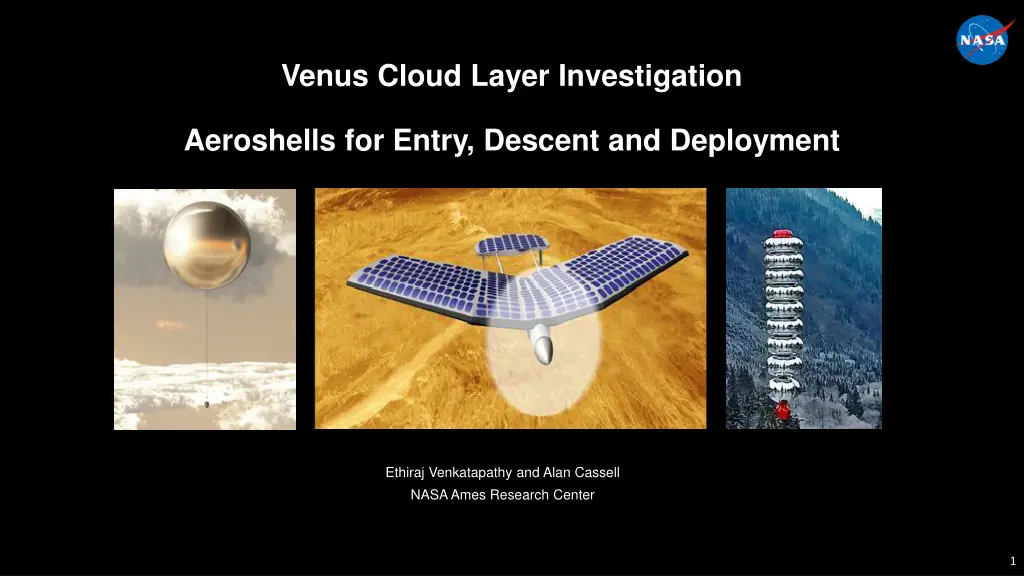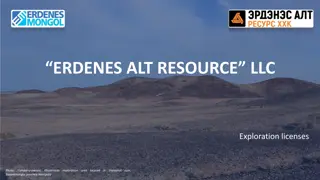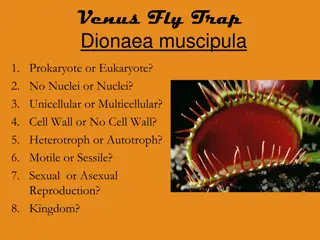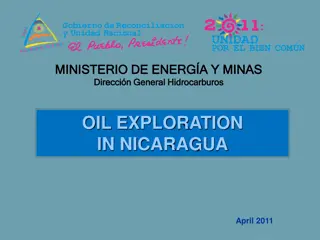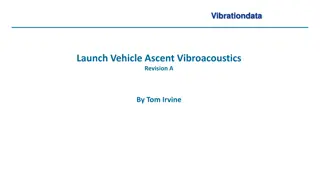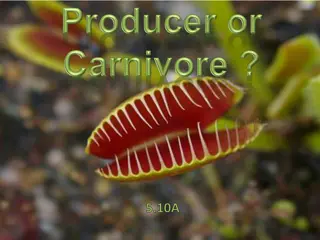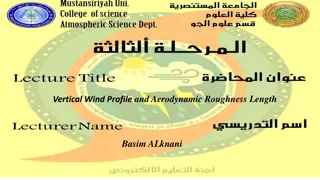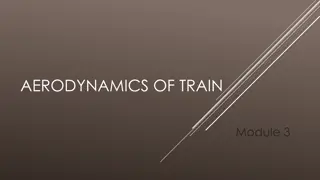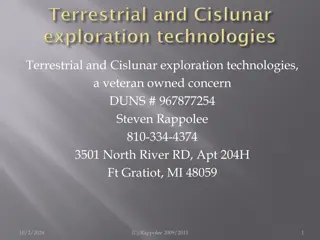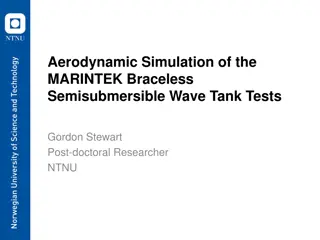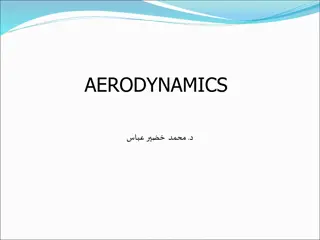Aerodynamic Challenges in Venus Exploration
Investigating aeroshells for Venus entry, descent, and deployment to overcome challenges. Technology developments for efficient and robust heatshield systems, enabling successful atmospheric missions. Discusses the demands of Venus entry compared to other planetary bodies. Engineering solutions and advancements in aeroshell technologies for future exploration.
Download Presentation

Please find below an Image/Link to download the presentation.
The content on the website is provided AS IS for your information and personal use only. It may not be sold, licensed, or shared on other websites without obtaining consent from the author.If you encounter any issues during the download, it is possible that the publisher has removed the file from their server.
You are allowed to download the files provided on this website for personal or commercial use, subject to the condition that they are used lawfully. All files are the property of their respective owners.
The content on the website is provided AS IS for your information and personal use only. It may not be sold, licensed, or shared on other websites without obtaining consent from the author.
E N D
Presentation Transcript
Venus Cloud Layer Investigation Aeroshells for Entry, Descent and Deployment Ethiraj Venkatapathy and Alan Cassell NASA Ames Research Center 1
Summary Entry, Descent and Deployment (EDD) of aerial platforms at Venus follows similar operational approach as landers. Limited only by the availability of mass efficient and robust aeroshell (heatshield/TPS) technology. Heatshield for Extreme Entry Environment Technology (HEEET) at TRL 6 is an enabler of Venus in-situ missions. Lower ballistic coefficient, deployable concept, ADEPT, offers additional options Low deceleration entry profile Release of one or more payloads (balloons) from open back of the entry vehicle 2
Venus Entry is Demanding but NASA has the Technology Venus entry is very challenging The Galileo Probe entry into Jupiter is the only NASA mission more stressing Heritage Carbon-Phenolic (HCP) no longer available NASA invested in the development of HEEET HEEET at TRL 6 is more robust and mass efficient (50% of the mass of HCP) A variant of HEEET is the baseline TPS for Mars Sample Return Earth Entry Vehicle. Mission Environments 100000 Values in parentheses are TPS mass fraction Galileo(50%) PioneerVenus(13%) 10000 Peak Heat Flux (W/cm2) Stardust(22%) 1000 Genesis(18%) Apollo(13.7%) 100 MPF (8.2%) MER (12%) MarsViking(2.8%) 10 0.01 0.1 1 10 Stagnation pressure (atm) 3
Is Venus Entry, Descent, and Deployment more Challenging? No! Venus has had more successful atmospheric entry missions (probes, landers, balloons) than any other solar system destination including Mars. The entry challenges into planetary atmospheres are very similar. With matured HEEET technology, the challenge is in engineering. To-date all entries into planetary bodies have been performed with rigid aeroshell Emerging deployable entry systems, may offer advantages along with their own constraints Venus Flagship mission study 4
Rigid Aeroshell Protects the Scientific Payload and Deploys it at the Right Location and Orientation Entry begins when atmospheric effects start to impact the system Function of Entry System: Safely deliver the payload from outside the atmosphere to a prescribed location within the atmosphere at prescribed condition (altitude, velocity and orientation) Protects from the entry aerodynamic deceleration loads due to drag Protects from entry heating (TPS) Achieve prescribed trajectory during entry as a result of aerodynamic stability All of the Venus entry missions to-date have been ballistic and non-lifting entry Typical Rigid Aeroshell Heatshield and Backshell attached to a structure Unguided ballistic entry Payload deployment relies on parachute after entry phase 5
Heatshield for Extreme Entry Environment Technology (HEEET) Developed to enable missions to Venus, higher speed sample return missions, and probes to Saturn, Uranus and Neptune in the coming decades. HEEET uses 3-D weaving with a dual layer construction: Outer layer: pure carbon, withstands extreme surface environments Insulative inner layer: blended yarn, manages the heat-soak. 6
Rigid Aero-shell Design Considerations: Entry Environments For entry angles between skip out ~(-80) and 12 , peak deceleration less than 100 g. VE= 11.5 km/s VITaL VME Peak stagnation point heat-flux is a function of both entry flight path angle and ballistic coefficient. higher b => higher heat-flux VCM PV North PV Night PV PV Day Large Heat-load increases significantly at lower entry flight path angle ( time of flight) TPS sizing (mass) depends on heat-load 3DOF survey of design space 7
A Small Probe for Venus Tech Demo Mission Current NASA project is targeted to deliver a flight ready aeroshell by 2024 for a dual technology demonstration mission in 2026 or later Probe is designed to reach the surface Meets 2023 Rocket Lab Mass and Volume Constraint. MEL Mass (lbs) Mass (kg) 8" MLB Upper Half Forebody Carrier Backshell Carrier Aft Bracket Bellyband Equipment Deck Battery Avionics Stack Forebody TPS Backshell TPS 0.78 4.12 4.37 0.80 0.67 2.54 1.76 0.25 5.42 0.48 0.35 1.87 1.98 0.36 0.31 1.15 0.80 0.11 2.46 0.22 Total Mass: 37.5 pounds (17 kg) 15.75 (40 cm) Capsule 4.2 (10.7 cm) Radius Nose 11.25 Nose to MLB Separation Plane MLB Upper Assy, TPS, Carrier, Deck, Battery, Avionics, Ballast, and MGA: 32 lbs (14.5 kg) Nose Ballast Mass Growth Allowance Payload 6.40 2.91 4.40 5.50 2.00 2.50 Total 37.48 17.04 8
Small Probe Descent Through the Cloud Layer Probe spends ~ 270 s in Clouds Probe could be designed to have Optical port in the back for cloud-layer investigation Descent time: 270 s Descent Velocity: 93 m/s - 38 m/s 9
Small Probe Entry Environments at Venus For Fly-By Opportunity, shallow efpa @ 10.75 km/s Entry flight path angle determines the peak deceleration HEEET is efficient insulator and can handle large heat-load at shallower entry flight path angle ~100g at low entry flight path angle Depending on Science need, can target constraining g-load Deployable may be a better alternate Peak Entry Conditions 10
Aerothermal Analysis 3D CFD Simulations DS-2 & PV w/o backshell Heating Prediction Comparison ( 11 km/s, EFPA=-10 , =5 ) Two configurations were considered from aerodynamic stability perspective DS-2 shape with a spherical back A flat back. Hi-fidelity CFD Simulations at moderate angle of attack including the flow on the base region can help guide potential science measurements during descent 11
Deployable Entry System Adaptive Deployable Entry and Placement Technology Lowering both the ballistic coefficient and entry flight path angle further lowers the peak heating and pressure. System and TPS verification is simpler based on ground test capabilities. Ballis. Coeff. EFPA Peak q, W/cm2 Peak G Heat-load, KJ/cm2 25 - 40 - 8.5 9.5 350 400 35 - 45 (7.5 10.0) 13
LLISSE-HEEET Technology Demo Opportunity Long Lived In Situ Solar System Explorer (LLISSE) Mission Concept Mission Design Study Objectives 1) Define carrier S/C accommodations (e.g. Discovery/New Frontiers class Orbiter @ Venus) for LLISSE & HEEET technology demonstration opportunity (TDO). 2) Define TDO operations concept assuming VERITAS baseline mission scenario. 3) Determine data uplink configuration and data volume. 4) Identify key design trades Next Steps 1) Evaluate other carrier spacecraft opportunities. a) Flyby spacecraft b) 24 hour elliptical orbiter 2) Consider targeted landing sites with flat surface to ease communication challenges. 3) Complete Mission Design Report. 4) Prepare FY 21 Content for Venus 2025 TDO. 14
